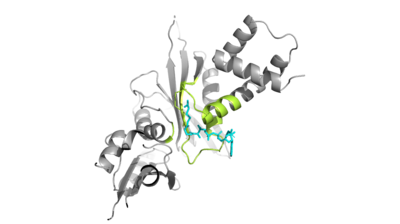User:Jordan Finch/Sandbox 1
From Proteopedia
(Difference between revisions)
| Line 15: | Line 15: | ||
Of the five classes of HAT enzymes, the catalytic mechanisms for two of those enzymes, HAT1 and Rtt109, remains unclear. A structural overlay of HAT1 and Gcn5, a more well-known and understood HAT enzyme, found a conserved glutamate residue in the active site of both molecules. It was found that mutation at that active site glutamate residue greatly alters the catalytic ability of HAT1 and has been proven to be structurally important. <ref> DOI:10.1101/gad.240531.114 </ref> Using this information and structural information regarding the proximity of potentially catalytic residues, the most plausible mechanism for histone acetylation involves the following relevant residues and cofactors <scene name='81/811713/Mechanism_glu_lys_coa/1'>Glu255, Lys14, and AcetylCoA</scene>. | Of the five classes of HAT enzymes, the catalytic mechanisms for two of those enzymes, HAT1 and Rtt109, remains unclear. A structural overlay of HAT1 and Gcn5, a more well-known and understood HAT enzyme, found a conserved glutamate residue in the active site of both molecules. It was found that mutation at that active site glutamate residue greatly alters the catalytic ability of HAT1 and has been proven to be structurally important. <ref> DOI:10.1101/gad.240531.114 </ref> Using this information and structural information regarding the proximity of potentially catalytic residues, the most plausible mechanism for histone acetylation involves the following relevant residues and cofactors <scene name='81/811713/Mechanism_glu_lys_coa/1'>Glu255, Lys14, and AcetylCoA</scene>. | ||
| - | In this mechanism, the glutamate at residue 255 acts as a general base and deprotonates lysine 12 of histone 4 (the numbering of the modified lysine residue on histone 4 is shifted two residues).The deprotonated lysine acts as a nucleophile and | + | In this mechanism, the glutamate at residue 255 acts as a general base and deprotonates lysine 12 of histone 4 (the numbering of the modified lysine residue on histone 4 is shifted two residues).The deprotonated lysine then acts as a nucleophile and attacks the carbonyl carbon of acetyl coenzyme A (CoA, forming a tetrahedral intermediate transition state. The negative charge on the oxygen collapses down to for a double bond and the scissle bond between the carbonyl carbon and the sulfur atom of acetyl CoA is broken. The resulting product of this reaction is histone 4 with an acetyl-lysine at residue 12 and CoEnzyme A. |
== Application == | == Application == | ||
Revision as of 17:44, 5 April 2019
Histone Acetyltransferase HAT1/HAT2 Complex, Saccharomyces cerevisiae
| |||||||||||

